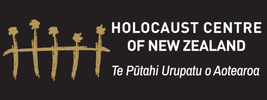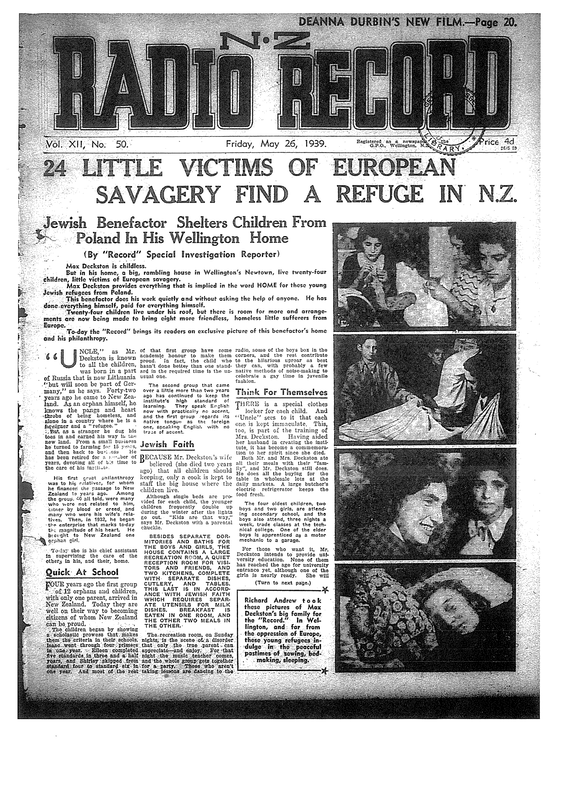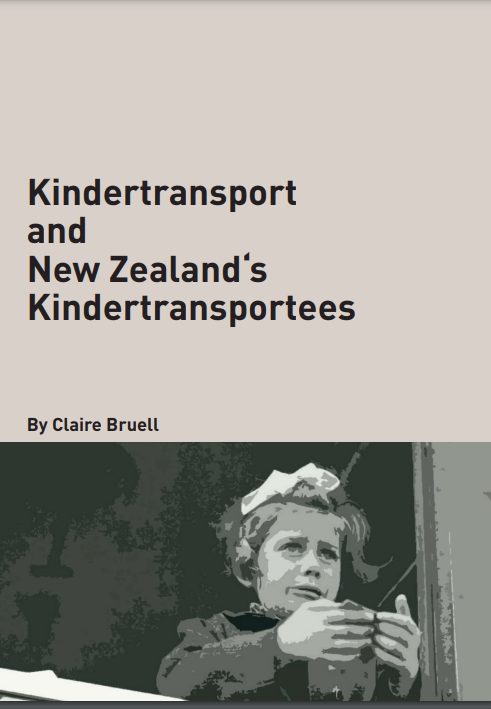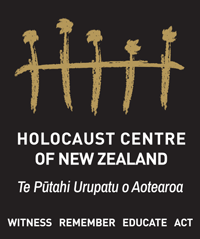NEW ZEALAND & THE HOLOCAUST
Response of NZ Government to Jewish Refugees/Holocaust Survivors, 1933-1948
by Dr. Ann Beaglehole
This essay looks at the NZ Government’s response to Jewish refugees fleeing Nazi-dominated Europe in the years prior to World War II and to Holocaust survivors in the years immediately following the end of the war.
In the 1930s/1940s, New Zealand preferred British settlers and placed strict controls on the immigration of racial minorities. The small number of Jewish refugees allowed into New Zealand (before and after the war) encountered prejudice and suspicion of cultural differences.
This essay looks at the NZ Government’s response to Jewish refugees fleeing Nazi-dominated Europe in the years prior to World War II and to Holocaust survivors in the years immediately following the end of the war.
In the 1930s/1940s, New Zealand preferred British settlers and placed strict controls on the immigration of racial minorities. The small number of Jewish refugees allowed into New Zealand (before and after the war) encountered prejudice and suspicion of cultural differences.
Jewish Internees in New Zealand, WWII
by Dr. Ann Beaglehole
Several men interned in New Zealand during World War II were Jewish, part-Jewish or had a Jewish background.
This essay focuses on these internees, who had come to New Zealand before the war as refugees from Germany and Austria, fleeing Nazism. For 3-4 years during the war they (and other anti-fascist refugees) were imprisoned with German nationals, including some fervent Nazis. At camps set up on Somes Island in Wellington Harbour and at Pahiatua in the North Island, Jewish internees were locked up and guarded “lest [they] escaped to help their mortal enemies”.
Several men interned in New Zealand during World War II were Jewish, part-Jewish or had a Jewish background.
This essay focuses on these internees, who had come to New Zealand before the war as refugees from Germany and Austria, fleeing Nazism. For 3-4 years during the war they (and other anti-fascist refugees) were imprisoned with German nationals, including some fervent Nazis. At camps set up on Somes Island in Wellington Harbour and at Pahiatua in the North Island, Jewish internees were locked up and guarded “lest [they] escaped to help their mortal enemies”.
Ann Beaglehole is a New Zealand writer and historian. In the 1950s, her family emigrated from Hungary to New Zealand as refugees following the Hungarian Revolution.
Her parents survived the Holocaust. She has written or contributed to over nine books and numerous articles, and was a past HCNZ Board member.
Her parents survived the Holocaust. She has written or contributed to over nine books and numerous articles, and was a past HCNZ Board member.
The Christchurch Refugees' Emergency Committee
From 1937 Dr. Ivan Sutherland, Professor of Philosophy at Canterbury University College, alongside Dr. Karl Popper, Dr. Roy Milligan, Dr. Otto Frankel were working to help [Jewish and other] refugees. The group was formalised in 1938 and known as the Christchurch Refugees’ Emergency Committee (CREC).
Dr. Sutherland took on the role of Chairman of the Executive Committee while Dr James Hight, the Rector of Canterbury University College, was the General Committee’s chairman. The Committee’s first official meeting, held on the 5th of December 1938, passed the resolution: "That in view of public ignorance and concern about what the Government has done and proposes to do in regard to the admission of refugees, the Government be urged to make an announcement along the lines of that recently made by the Australian Government."
The climate in New Zealand around welcoming refugees at the time was contentious. The government was reluctant to allow refugees into the country for a multitude of reasons. There were concerns around the impact of refugees on the unemployment rates of New Zealanders. The country did not consider itself antisemitic, and leadership feared an increase in antisemitism if more Jewish immigrants were to arrive.
...
The Committee continued to operate throughout the duration of World War II, from 1939 to 1945. In eight years of operation, the Committee eventually received 108 applications for a total of 216 people. They were able to successfully gain permits for 32 applications making up 61 individual refugees. Unfortunately, this means 70% of the applications they supported were denied.
Deckston Orphanage
Annie and Max Deckston (originally from Belarus), came to New Zealand via London in 1900.
Initially farmers in the lower North Island, the Deckstons moved to Wellington when farm life became too onerous. They acquired a number of businesses and properties - and 20 years after first arriving in New Zealand they had accumulated enough wealth to help others.
As Annie and Max were childless, they decided to set up an orphanage for Jewish children. The Deckstons brought 20 orphans to New Zealand (including, amongst them, relatives from Bialystok, Poland) – the first eight in 1935 and a further 12 in 1937.
They accommodated them in a large property in Wellington and raised them in a Jewish environment.
The children who came to the Deckston orphanage all survived. Some assimilated fully into New Zealand life, while others moved to Australia (where there was a large Jewish community from Bialystok).
Initially farmers in the lower North Island, the Deckstons moved to Wellington when farm life became too onerous. They acquired a number of businesses and properties - and 20 years after first arriving in New Zealand they had accumulated enough wealth to help others.
As Annie and Max were childless, they decided to set up an orphanage for Jewish children. The Deckstons brought 20 orphans to New Zealand (including, amongst them, relatives from Bialystok, Poland) – the first eight in 1935 and a further 12 in 1937.
They accommodated them in a large property in Wellington and raised them in a Jewish environment.
The children who came to the Deckston orphanage all survived. Some assimilated fully into New Zealand life, while others moved to Australia (where there was a large Jewish community from Bialystok).
|
New Zealand Radio Record (Periodical), 26 May 1939
This periodical was later absorbed by the New Zealand listener. |
Testimony of Deckston child Eileen Silestean ( Chaya Sierota)
read by her daughter Lisa Silestean |
New Zealand's Kindertransportees
Kindertransport was the unofficial name given to the rescue of between 9 and 10,000 mostly Jewish children brought from Europe between 1938 and 1940. While most went to Great Britain, small groups were also sent to Sweden, Holland and Belgium, and around 1,400 were transported to the USA. These children survived due to the Kindertransport and some found a new life of freedom in New Zealand.
Here are 13 of these stories, compiled by Claire Bruell, from over 90 oral history recordings with Holocaust survivors in New Zealand (mainly Auckland) and contributions from their families.
Despite their stolen childhoods, the children lived fulfilling lives after the war, studying, marrying and having families of their own. The majority of these 13 children who remained in New Zealand lived their adult lives as contributing individuals to New Zealand society.
Click image to read more.
Here are 13 of these stories, compiled by Claire Bruell, from over 90 oral history recordings with Holocaust survivors in New Zealand (mainly Auckland) and contributions from their families.
Despite their stolen childhoods, the children lived fulfilling lives after the war, studying, marrying and having families of their own. The majority of these 13 children who remained in New Zealand lived their adult lives as contributing individuals to New Zealand society.
Click image to read more.
Jewish Contribution to New Zealand
Jewish Doctors in New Zealand
In 1930s Germany, Jewish doctors were denied the right to practice (with the exception of war veterans). They had no access to hospitals - except Jewish ones - and were unable to study medicine. Doctors who could leave Germany, began to do so.
In New Zealand, there was a requirement for all foreign doctors to undertake a further year of study at Otago Medical School in Dunedin. In 1936/37 this was extended to three years and, in 1938, to the full six years.
Records show that of the 68 doctors who were granted permits to enter New Zealand during this time, 34 were eventually registered to work here. Of the more than 2,000 Jewish doctors in Berlin, eight came to work in New Zealand.
Diaspora by Design - Jewish Refugee Architects in New Zealand
In the 1930s, New Zealand received a wave of highly trained artists, architects and musicians fleeing Nazism. Six Jewish architects, in particular, had a significant influence on New Zealand’s architectural landscape and culture: Helmut Einhorn, Ernst Plischke, Friedrich Neumann (Newman from 1948/1900-64), Henry Kulka, Maximillian Rosenfeld, and Robert Fantl.




